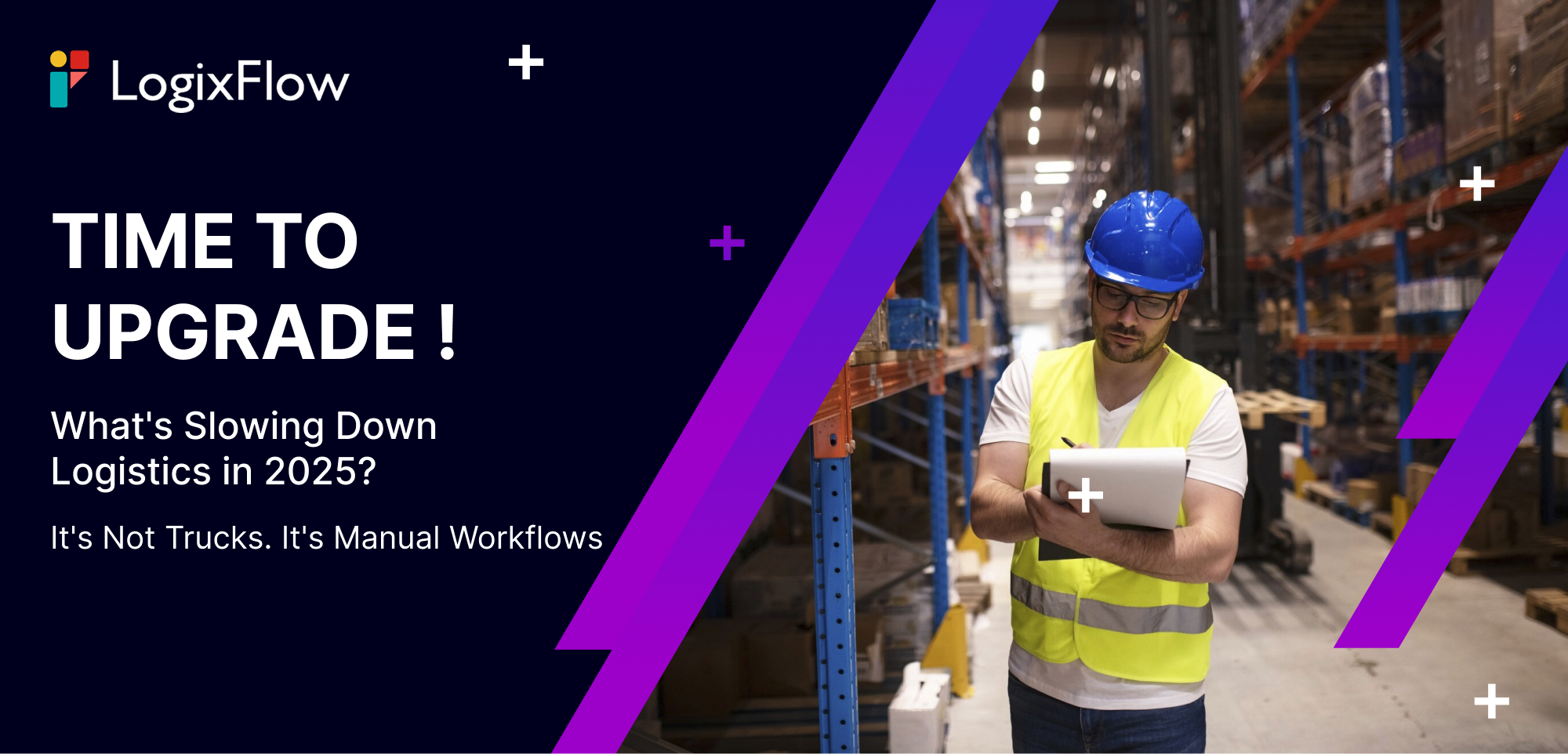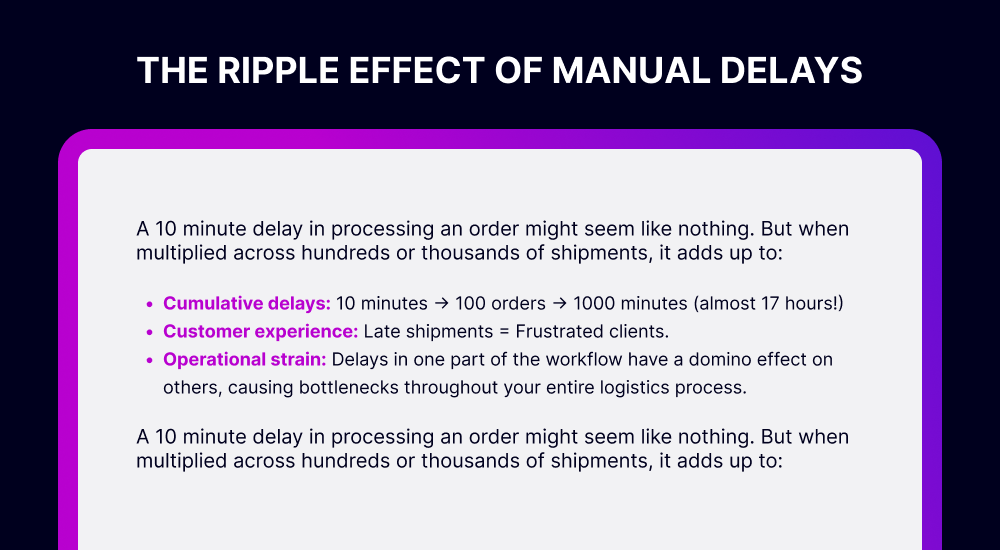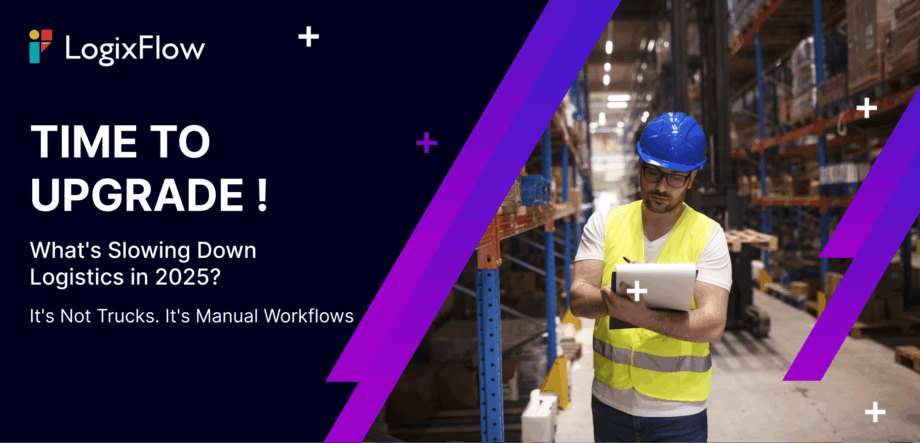
The Hidden Cost of Manual Workflows in Logistics (And How to Escape Them in 2025)
We all know the myth of storks delivering babies worldwide with their perfect timing. But imagine if the storks had to:
- Wait 3 days for invoice approvals.
- Cross-reference spreadsheets to find one missing package.
- Delayed shipment because someone typed AM instead of PM.
This isn’t far from what’s happening in the logistics world today except the babies are your shipments, and the stork is another overworked employee. It’s okay for Storks to use notepads, sticky notes and spreadsheets to carry out their shipment delivery but not your logistics team.
Every paper form, missed update, or manual approval isn’t just slowing you down, it’s actively costing you revenue.
Logistics moves fast. The technological upgrade in the field of logistics is so goated right now but some teams are still stuck in slow mode. The big players like Amazon Prime (Oh! Guess, named for a reason) are shipping at lightning speed while some teams are sipping coffee because they had a hectic day at work.
You know why it’s hectic? Because the work moves at a slow pace. Why slow pace? Still using manual workforce in the places that automation should have been replaced a while ago.
P.S. The goal isn’t to replace the manual workforce entirely. As the saying goes, “With great power comes great responsibility.” With the power of AI in hand, we have the opportunity to put human potential to better use focusing on roles that require judgment, creativity, and critical thinking, while letting machines handle the repetitive and time-sensitive tasks.
Still not convinced? Then, read below.
Manual processes aren’t just slow, they are increasingly unaffordable in this fast moving industry. Slowed-down operations, limited scalability, inefficiencies, inconsistencies, errors, and repetitive task fatigue are the reasons. This messy manual crawl routine is costing far more than just a little extra time; unaware of the hidden costs slowly draining their efficiency, revenues and growth potential. As we hit 2025, the margin for inefficiency is shrinking fast. Manual processes are no longer just an inconvenience; they pose a major business risk.
As we move closer to a more automated future, the margin for operational gaps shrinks more quickly. If you continue to depend on manual tasks, it’s a bit like playing football with eyes closed: slow and, let’s face it, kind of risky.
Fortunately, escaping the trap of operational gaps is not just possible, it’s easier and more affordable than ever. Thanks to innovations like no-code workflow automation platforms such as Logixflow, even the busiest logistics operations can simplify their processes without needing a science behind the blackhole or a billionaire’s budget.
So, let’s look into the real costs of manual operations and see how the smartest logistics businesses are preparing for a 2025 where everything just… FLOWS.
Ahem. A little thinking is needed before adapting to the workstyle of “Faster than Fast.”
The Hidden Costs of Manual Workflows in Logistics
Manual workflows can often seem “cheaper” or “simpler” at first glance. However, under the surface, they slowly erode your business in many ways:
- Inefficiency and Time Loss
The logistics crew often spend hours sorting, filing and retrieving documents, time that could be better used for higher-value tasks. Paperwork moves so slow, even the trucks start honking at it.
Every manually filled form, paper based approval and manually updated database cuts productive hours. It’s like while you are on your first task your competitors are past their checklist. Manual operations in logistics could mean the difference between a delivered shipment and a missed deadline. - High Error Rates
Not everyone is that one practiced pharmacist who interprets the doctor’s scribbled handwriting.
Manual data entry, inventory tracking and shipment scheduling are highly prone to human errors. A single misplaced entry or forgotten update can snowball into costly shipping delays, lost inventory and BOOM unhappy customers. Yikes! - Lack of Real-Time Visibility
From the perspective of the common saying “Modern problems require modern solutions,” modern logistics requires real-time tracking and decision making. Manual workflows prevent rapid visibility into shipment statuses, inventory levels or operational obstacles, leaving you squinting at spreadsheets. The result? Delayed response times and losing valuable contracts. - Poor Scalability
When your operations grow, manual workflows don’t scale with you. Instead, they create obstacles that require more staff, more paperwork and more resources, driving up costs and slowing down your growth. - Compliance Risks
The logistics sector is heavily regulated. Manual record-keeping complicates compliance and increases the probability of errors in audit processes, kind of like trying to find that one missing receipt from two years ago, with one eye closed. This exposes businesses to fines, legal challenges and reputational damage.
The bottom line?
Manual workflows cost you much more than you realize, both financially and operationally. The real cost of manual workflows? They anchor your business to yesterday’s pace in a market that rewards tomorrow’s speed.

How to Escape Manual Workflows in 2025: The Power of No-Code Automation
The good news is that the logistics industry is undergoing a revolution, and no-code automation is at the heart of it. Finally, a solution that doesn’t require your team to have a CPU for a brain.
The Logixflow permits logistics businesses to leave manual workflows behind, without requiring massive IT investments or coding expertise.
You can turn zero to a hundred and above real quick.
Here’s parcel points of Logixflow that could be the route to your logistics wins:
- Build Custom Workflows with No-Code Simplicity
With Logixflow’s drag-and-drop Studio, logistics companies can quickly design and automate procurement workflows, shipment tracking, inventory management, invoice approvals, and more, without writing a single line of code. If you can drag-and-drop a file on your desktop, you’re already halfway there. - Integrate Seamlessly Across Systems
Manual re-entry of data between systems is a major cause of delays and errors. Logixflow’s integration capabilities allow logistics businesses to seamlessly connect their CRM, ERP, and third-party apps, creating unified workflows across their entire operations. Think less Ctrl+C, Ctrl+V… and more “it just works.” - AI-Powered Decision Making
Say hello ALYA, the core of Logixflow, an integrated AI agent that provides predictive insights, suggests workflow optimizations and supports smarter, faster decision making. In an industry where a minor delay can ripple across the supply chain, real-time AI driven support is a game changer. - Real-Time Data and Analytics
With Logixflow, logistics companies can access dynamic dashboards, insightful reports, and real-time tracking, enabling better forecasting, instant problem resolution, and continuous workflow optimization. Translation: no more “fingers crossed” shipping estimates. - Scalability for the Future
Whether you’re managing 100 shipments a month or 100,000, Logixflow scales with your business. As your operations grow, you can easily modify workflows, add users, and adapt processes without expensive IT projects. Scaling without breaking a sweat or the bank, oops!
Real-World Impact: Manual vs Automated Logistics
Table 1: Manual Moments That Multiply: The Hidden Math of 1 Task
| Workflow Task | Time per Task | Frequency (per day) | Monthly Time Drain | Yearly Time Sink | Annual Cost(USD@$15/hr) |
|---|---|---|---|---|---|
| Shipment Status Update | 4 mins | 25 times | 33 hours | 396 hours | $5940 |
Imagine this:
- A customer requests a pickup. The quote must be shared manually, followed by approvals, document review, and coordination with the dispatch team. With so much back-and-forth, there is a high risk of human errors, such as wrong quotes, misplaced paperwork or delayed vehicle dispatch… you get the drift.
- Logixflow automates the whole process, from quote generation to approvals to pickup scheduling, to make sure nothing slips through the gaps and the shipping runs smoothly.
Result? Faster deliveries, lower operational costs, happier customers and a logistics operation that’s ready to take on 2025 and beyond. Now, that’s how logistics should flow.
Why 2025 Will Be the Tipping Point
“Where’s my package?” isn’t a question, it’s a countdown clock.The logistics landscape is changing faster than ever:
- Customer expectations for real-time updates and faster deliveries are growing.
- Sustainability pressures are forcing businesses to eliminate waste.
- Economic uncertainty demands cost control and operational agility.
Manual workflows simply won’t survive these pressures.
Logistics businesses that use intelligent, no-code automation will have the edge, delivering better service, scaling faster, and staying resilient in a rapidly evolving market.
Logixflow is the backbone of a future proof logistics operation, is it not?
Make 2025 the Year You Leave Manual Workflows Behind
The hidden costs of manual workflows are real and growing.
But so is the opportunity to grow your logistics operations through no-code, AI powered automation.
With Logixflow integration, you don’t need a team of developers or a massive IT budget to revolutionize your processes.
You just need the right tools and the vision to use them.
Ready to break free from manual workflows and future-proof your logistics business?
Experience Logixflow today and take the first step into a smarter, faster, and more secure 2025.


